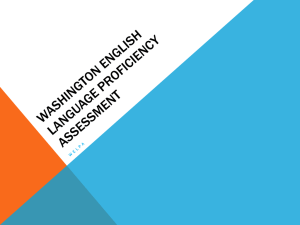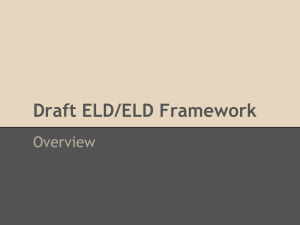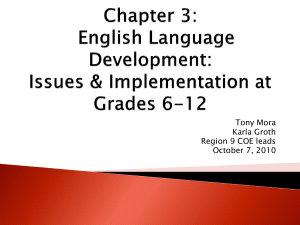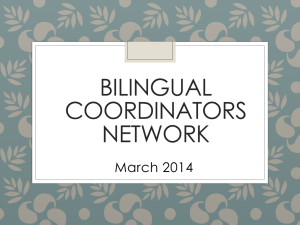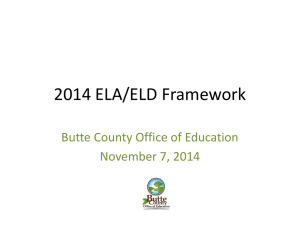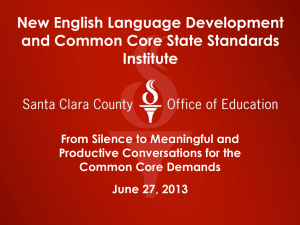Secondary English Learners
advertisement
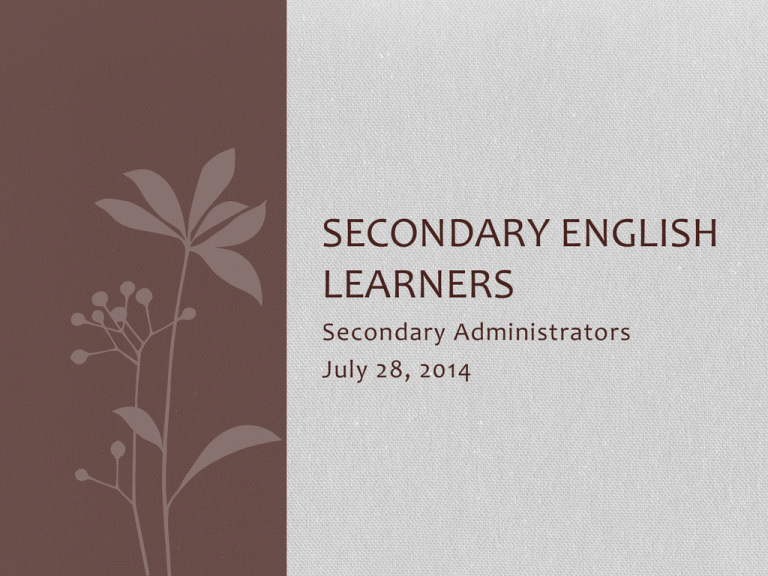
SECONDARY ENGLISH LEARNERS Secondary Administrators July 28, 2014 . English Learners • Watch the video • Note two of the EL issues that are presented that stand out to you. Respond to the writing prompt at the end of the video • http://youtu.be/s2YKNk4P-wA Ch ch ch Changes………. Common Core Standard Staircase Result in College and Career Readiness • Based on solid research and practice evidence • Fewer, Higher and Clearer EL’s must demonstrate EL’s must obtain understanding & confirm being understood. information and request clarification . Language Demands of the Common Core Standards El’s must construct explanations, engage in arguments. EL’s must articulate their own ideas and build on others’ ideas. 6 ELA SHIFTS in Standards • Literacy Standards for Content Areas • Increased Emphasis on Informational Text • Text Complexity • Writing Arguments • Focus on Collaborative Conversations • Integration of Media Sources Special care to appropriately scaffold the journey for our EL’s so they can climb too. Key Shift in the Common Core: Language development across the curriculum •Language development occurs within a dedicated ELD curriculum (designated ELD) •AND across all academic subjects (integrated ELD). Key Shift in the Common Core: Language development across the curriculum • Academic language develops in the context of learning academic subjects – students learn to talk and write about history, science, math, through a focus on the language of the academic disciplines. Key Shift in the Common Core: Language development across the curriculum •The CCSS call upon all content teachers to focus more explicitly on the discourse patterns, vocabulary and oral language essential to full participation in academic work within their disciplines. Key Shift in the Common Core: Language development across the curriculum •All teachers need an understanding of literacy and language, and the strategies to promote active engagement with language in the content classroom. 3 Instructional Shifts • Reading, writing, speaking grounded in evidence from text, both literary and informational Focus on creating opportunities and developing strategies for increasing student discourse and collaborative conversations which includes the use of daily language objectives in all EL instructional settings. • Regular practice with complex text and its academic language. • Building knowledge through content rich non fiction. Targeted academic vocabulary instruction and strategies to enable access to complex text In addition………. • CA ELD Standards • Local Control Funding Formula • Publishers racing to create materials that are aligned to the new Common Core and CA ELD Standards • SBAC WCCUSD Support for Secondary EL Programs Rebuilt Master Plan for English Learners Monthly ELD Departmental Meetings Secondary ELD Consultant Support CA 2012 ELD Standards Overview Brokers of Expertise WCCUSD English Learner Master Plan • • • • • • Components Identification, Assessment and Program Placement Instructional Programs Monitoring of Student Progress and Reclassification Parent and Community Involvement Evaluation and Accountability Appendix with Legal References and Glossary Still work to do……… • EL Master Plan goes to board in August • Plan will be implemented in phases • Introduction to WCCUSD staff and community will occur at various meetings and events throughout the school year. • Operations manuals for Registration, Assessment and Placement (RAP) and EL Program to be published later this year. Educators have a Dual Obligation to English Learners • Provide meaningful access to grade-level academic content via appropriate instruction (Integrated ELD) • Develop students’ academic English language proficiency (Designated ELD) Interconnected, not separate! Simultaneous, not sequential! So what will help our teachers? • 2012 ELD Standards • Sustained collaboration and professional learning around key problems of practice • Deep understanding of disciplinary literacy (content AND language knowledge) • Formative assessments within teaching and learning Why establish ELD standards? • English learners at all English language proficiency levels are capable of engaging in intellectually rich instruction in all content areas. • English learners bring primary language resources that should be valued in their own right and used as a resource for learning English. • English learners learn both language and content through meaningful interactions with others and by learning about how language works to make meaning. ELD Shifts: New ELD Standards • Adopted on November 7, 2012 by SBE • Correlated to CCSS & designed to help ELs build critical knowledge and skills • Describe key knowledge, skills, and abilities in core areas of ELD http://www.cde.ca.gov/sp/el/er/eldstandards.asp California Implementation Timeline 2011 October AB124 Mandates Revision of ELD Standards 2010 August SBE Adopts Common Core State Standards 2012 November SBE Adopts ELD Standards 2015-2016 Development of new ELPAC assessment 2013 December ELA/ELD Curriculum Framework developed for public review. 2014 June (anticipated) ELD Standards to be reformatted and aligned to New Generation Content Standards. What’s on the Horizon •2015-16—ELP Assessments for California (ELPAC) • 2016—ELA/ELD K-8 Instructional Materials Adoption EL K-12 Standards Support Plan for 2014-15 • Various Professional Development Series on the new ELD Standards. • Monthly Sheltered or SDAIE Support meetings (new) in addition to continuing monthly ELD Departmental meetings. • CCSS and ELD Standards Aligned secondary materials pilot at RHS and Helms. • Centrally funded GLAD training for elementary and secondary teachers. Let’s take a look at the CA ELD Standards…………. Amplify critical knowledge about English language skills in the CCSS for ELA/Literacy that English learners need to be successful in school To be used by content area teachers as well as ELD teachers to ensure support for our EL students. Proficiency Level Descriptors Include: • Overall Proficiency (entry & exit) • Extent of linguistic support needed • Describe knowledge, skills, and abilities across a continuum • Three levels: Emerging, Expanding, Bridging at early and exit stages • Guide targeted instruction in ELD and differentiated instruction in content areas ELD STANDARDS • • • Amplify ELA Standards Organized by grade level Divided into 3 parts • • • Interacting in Meaningful Ways Learning About how English Works Using Foundational Literacy Skills LOOK AT THE STANDARDS Standards Walk • Work with a partner at your table • Pick one grade level ELD standard • Read the emerging description • Read the expanding description of the same standard – highlight what you see has been added in comparison with the emerging description. • Now read the bridging description of the same standard – highlight what you see has been added in comparison with the expanding description. • Be prepared to share what you saw with the rest of the group. What should we see in the classrooms? ELD Language objective Academic vocabulary Focus on language structures and functions Opportunities for oral practice Collaborative Conversations Visual Cues Graphic Organizers Sheltered Content and related language objective Academic vocabulary Focus on language structures and functions Opportunities for oral practice Collaborative conversations Visual Cues Graphic Organizers Points to Consider What tasks do I want my students to be able to complete independently? •Determine the central ideas from various texts and summarize accurately (7th Grade History Literacy 2.0) •Explain ideas based on close readings of grade-level texts (7th Grade ELD – Writing 6-A) What do I need to consider getting them to that point? •The academic language they need to be successful •Their language needs according to their PLD (emerging, expanding, bridging) •How to make our time together relevant, challenging, and engaging What tools do I have to put all of this together for my students? •Scaffolding •Differentiation •Integrated instruction I Ah-ha! If I integrate the academic content and ELD standards, my students will develop both the academic and English fluency. am the best teacher ever! Integrated and Designated ELD: Working in Tandem Integrated ELD: All teachers with English learners in their classrooms use the CA ELD Standards in tandem with the CA CCSS for ELA/Literacy and other content standards. Designated ELD: A protected time where teachers use the CA ELD Standards as the focal standards in ways that build into and from content instruction. What should we see EL students doing in ELD and Sheltered/SDAIE classrooms? • Engaging in productive oral discourse and written group work with peers that incorporates academic vocabulary tied to the lesson or unit of study. • Participating in effective oral discourse and written communication with teachers. • Explaining and demonstrating their knowledge using emerging complex language, academic vocabulary and other communicative strategies in different settings. • Extracting meaning from complex written texts. WE MUST ENSURE DAILY, HIGH QUALITY ELD INSTRUCTION FOR OUR EL STUDENTS • • • Administrators have to know what to look for in ELD • Daily language objectives that frame opportunities for discourse and collaborative conversations using academic language. • Using genuine formative assessments to guide instruction frequently. Walk through the classrooms regularly to ensure it happens Ensure that ELD teachers have opportunities for feedback on their instruction and time to collaborate with one another. What should we see in the classrooms? ELD Language objective Academic vocabulary Focus on language structures and functions Opportunities for oral practice Collaborative Conversations Visual Cues Graphic Organizers Sheltered Content and related language objective Academic vocabulary Focus on language structures and functions Opportunities for oral practice Collaborative conversations Visual Cues Graphic Organizers What should we see EL students doing in ELD and Sheltered/SDAIE classrooms? • Engaging in productive oral discourse and written group work with peers that incorporates academic vocabulary tied to the lesson or unit of study. • Participating in effective oral discourse and written communication with teachers. • Explaining and demonstrating their knowledge using emerging complex language, academic vocabulary and other communicative strategies in different settings. • Extracting meaning from complex written texts. Let’s Practice - ELD • Pick a partner at your table • Read the ELD vignette • Work together to highlight examples in the vignette that illustrate teacher and student behaviors that are listed in your packet • Discuss with your partner how you would structure teacher feedback based on this vignette • Be ready to share out Designated ELD Vignette Grades 9 and 10 MacBeth Let’s practice – ELD https://www.teachingchannel.org/videos/ellessay-structure-lesson ELD Placement: To assign El students into appropriate ELD levels based on diagnosed English proficiency and writing skills Test Format The test is made up of two sections: Reading Writing □The reading section is scored by the number of questions answered correctly. The student’s reading score determines a reading proficiency level 1-4. □The writing section goes through a first and second read by experienced ELD teachers. A third read is required when the first and second reader do not agree on the writing proficiency level (1-4) ELD Writing Proficiency Descriptors Comments Specific to EL Status ELD 4 – Uses most standard grammatical forms, has ample knowledge of affixes, synonyms, antonyms, figurative language, varies word ◊ If an El student scores higher than at the ELD 4 choice, multiple meaning words, uses Level with a score of “5”, he/she is placed in a supporting details. general English class without an additional ELD class. We call this student an EL Profile Student. ELD 3 – Uses several standard grammatical forms, common knowledge of affixes, An EL Profile Student must continue to receive synonyms, antonyms, descriptive language, English learner services from the general English dialogue, states a main idea with some teacher. The teacher must support the El by supporting details. diagnosed need in order to successfully meet all of the criteria to officially exit the program as a ELD 2 – Uses some standard grammatical forms, reclassified fluent English proficient (R-FEP) some knowledge of phonemes, morphemes, student. high frequency words, simple figurative language, story elements, basic descriptive vocabulary, can identify a main idea and supporting details. ELD 1 – Uses few grammatical forms (simple sentences, use of present tense of regular verbs, present progressive, past tense regular verbs, simple future, articles, possessive and descriptive adjectives, simple punctuation, paragraph development with simple transition words.
